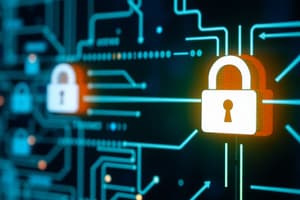Podcast
Questions and Answers
What is the primary function of a firewall in network security?
What is the primary function of a firewall in network security?
- To detect and block malware
- To monitor and control incoming and outgoing network traffic (correct)
- To encrypt data for secure transmission
- To manage network user access
Which of the following is a common characteristic of Denial-of-Service (DoS) attacks?
Which of the following is a common characteristic of Denial-of-Service (DoS) attacks?
- Overwhelming a service to make it unavailable (correct)
- Disguising as a trustworthy source to obtain sensitive information
- Intercepting communication between two parties
- Using malicious software to gain unauthorized access
What does an Intrusion Prevention System (IPS) do?
What does an Intrusion Prevention System (IPS) do?
- Enforces security policies across the network
- Actively blocks detected threats in real-time (correct)
- Monitors network traffic for suspicious activity
- Alerts administrators about network breaches
What is the significance of using Virtual Private Networks (VPNs)?
What is the significance of using Virtual Private Networks (VPNs)?
Which practice is NOT considered a best practice for network security?
Which practice is NOT considered a best practice for network security?
What type of attack involves manipulating communication without the parties' knowledge?
What type of attack involves manipulating communication without the parties' knowledge?
Which of the following is a benefit of network segmentation?
Which of the following is a benefit of network segmentation?
What emerging technology can enhance security in transactions through decentralized ledgers?
What emerging technology can enhance security in transactions through decentralized ledgers?
Flashcards are hidden until you start studying
Study Notes
Network Security
-
Definition: Protection of networks from unauthorized access, attacks, and misuse.
-
Key Components:
- Firewalls: Monitor and control incoming and outgoing network traffic based on predetermined security rules.
- Intrusion Detection Systems (IDS): Monitor network traffic for suspicious activity and alert administrators.
- Intrusion Prevention Systems (IPS): Actively block detected threats in real-time.
- Virtual Private Networks (VPNs): Secure connections over the internet that encrypt data to protect privacy.
-
Types of Attacks:
- Denial-of-Service (DoS): Overwhelming a network or service, making it unavailable to users.
- Man-in-the-Middle (MitM): Interception and alteration of communication between two parties without their knowledge.
- Phishing: Fraudulent attempts to obtain sensitive information by disguising as a trustworthy entity.
- Malware: Malicious software that disrupts, damages, or gains unauthorized access to systems.
-
Best Practices:
- Regular Updates: Keep software, firmware, and security patches up to date to protect against vulnerabilities.
- Network Segmentation: Divide networks into segments to limit access and contain breaches.
- Strong Authentication: Implement multi-factor authentication (MFA) to enhance security.
- Monitoring and Logging: Continuously monitor network activity and maintain logs for auditing and forensic analysis.
-
Security Policies:
- Develop and enforce policies governing acceptable use, data protection, and incident response.
- Regularly conduct security training for employees to raise awareness of potential threats.
-
Emerging Technologies:
- Artificial Intelligence (AI): Used for threat detection and response automation.
- Blockchain: Enhancing security in transactions and data integrity through decentralized ledgers.
-
Compliance and Standards:
- Adhere to regulations such as GDPR, HIPAA, and PCI-DSS to ensure proper handling of sensitive information.
-
Incident Response:
- Establish a response plan that includes identification, containment, eradication, recovery, and lessons learned.
Network Security Overview
- Protection of networks against unauthorized access, attacks, and misuse.
Key Components
- Firewalls: Essential for monitoring and controlling incoming/outgoing traffic based on security rules.
- Intrusion Detection Systems (IDS): Continuously monitor network traffic for suspicious activities; notify administrators.
- Intrusion Prevention Systems (IPS): Actively block threats detected in real-time to prevent damage.
- Virtual Private Networks (VPNs): Encrypt internet connections to safeguard privacy and secure data transmission.
Types of Attacks
- Denial-of-Service (DoS): Attack where services are overwhelmed, rendering them unavailable to legitimate users.
- Man-in-the-Middle (MitM): Attack that involves intercepting and altering communications between two parties without detection.
- Phishing: Scams designed to trick individuals into revealing sensitive information under the guise of a trustworthy source.
- Malware: Any malicious software intended to disrupt, damage, or gain unauthorized access to systems.
Best Practices for Security
- Regular Updates: Crucial for keeping software, firmware, and security patches current against vulnerabilities.
- Network Segmentation: Breaking networks into smaller segments to restrict access and mitigate the impact of breaches.
- Strong Authentication: Implementation of multi-factor authentication (MFA) enhances overall security posture.
- Monitoring and Logging: Ongoing network activity surveillance and log maintenance for auditing and forensic purposes.
Security Policies
- Development and enforcement of comprehensive policies governing acceptable use, data protection, and incident response.
- Conduct routine security training for employees to enhance awareness of potential security threats.
Emerging Technologies in Security
- Artificial Intelligence (AI): Utilized for automating threat detection and response processes.
- Blockchain: Improves security in transactions and data integrity through the use of decentralized ledgers.
Compliance and Standards
- Adherence to relevant regulations like GDPR, HIPAA, and PCI-DSS to ensure proper handling of sensitive data.
Incident Response
- Establishment of a structured response plan encompassing identification, containment, eradication, recovery, and post-incident analysis.
Studying That Suits You
Use AI to generate personalized quizzes and flashcards to suit your learning preferences.




